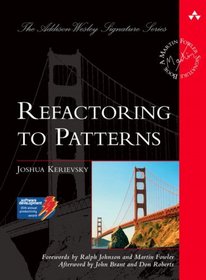Search -
Refactoring to Patterns (Addison-Wesley Signature Series)
Refactoring to Patterns - Addison-Wesley Signature Series
Author:
What Is This Book About? — This book is about the marriage of refactoring—the process of improving the design of existing code—with patterns, the classic solutions to recurring design problems. Refactoring to Patterns suggests that using patterns to improve an existing design is better than using patterns early in a new design. This is ... more »
Author:
What Is This Book About? — This book is about the marriage of refactoring—the process of improving the design of existing code—with patterns, the classic solutions to recurring design problems. Refactoring to Patterns suggests that using patterns to improve an existing design is better than using patterns early in a new design. This is ... more »
ISBN-13: 9780321213358
ISBN-10: 0321213351
Publication Date: 8/5/2004
Pages: 400
Rating: ?
ISBN-10: 0321213351
Publication Date: 8/5/2004
Pages: 400
Rating: ?
0 stars, based on 0 rating
Publisher: Addison-Wesley Professional
Book Type: Hardcover
Members Wishing: 2
Reviews: Amazon | Write a Review
Book Type: Hardcover
Members Wishing: 2
Reviews: Amazon | Write a Review
Genres:
- Computers & Technology >> Programming >> Software Design, Testing & Engineering >> Object-Oriented Design




